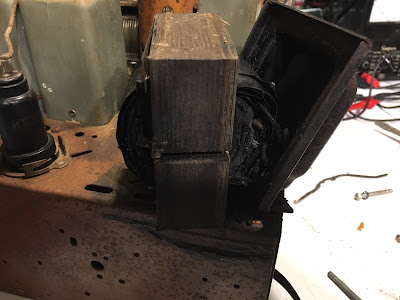 |
| MOPA rig with N3ZI VFO |
I think I was probably eight or nine years old when I began lugging home and systematically dismantling junked radio and TV sets, something that became almost an obsession with me in my pre-teen years.
People threw away some cool stuff in the early 1970s, when one could count on harvesting at least one old black and white television set from among the household rubbish set out for collection, and I got good at retrieving them.
Garbage night was something of a weekly holiday; I'd rush home from school, grab my bike and begin hovering the neighborhood, hoping to catch someone in the process of dragging one of the old behemoths to the curb. If my reconnaissance mission were successful, the next challenge faced was getting the thing home. With smaller sets, I found that I could dismount my steed and precariously balance my bounty on the seat and handlebars of my Sting-Ray bicycle. Larger, console sets posed a greater challenge, because I'd have to zip home, grab a wheelbarrow and zip back before someone else claimed my prize. Much to my parent's dismay, my success rate was pretty decent.
With the derelict safely on the workbench, I'd begin the laborious disassembly process. Every part would be identified, carefully unsoldered (no lead clipping for this kid!) and added to my ever expanding inventory. Tubes were carefully sorted and stored in egg cartons, resistors, capacitors and small inductors were taped to index cards and categorically filed for easy retrieval, while the crown jewels: transformers, would be stashed under my bed in old shoe boxes.
Meanwhile, I'd be pouring over the various books and magazines, dreaming of building some of the featured projects. Unfortunately, I wasn't quite there yet.
I wonder whatever happened to all that junk? I should ask my mother.
Fast forward another 35 years. While I don't practiced "Alley Picking" like I did as a kid, I had somehow amassed another hoard of salvaged parts. But, this time, thanks to skills acquired over time and the endless resources available on the web, I knew I'd be able to do something with them.
In the search for candidate projects, I came across an article from the September 1964 Electronics Illustrated on KH6SKY's web page that described a simple 6V6 CW transmitter built from junkbox parts, appropriately named "The Scrounger".
The Scrounger was built on an inverted cake pan, which, enjoying cake as I do, appealed to me. So, I built my first Scrounger prototype, which was reasonably faithful to that described in the EI article. The damned thing actually worked, and I made quite a few contacts until disaster struck: I accidentally set some papers down on my J-38 without a crystal in the rig and zorched the transformer.
That unfortunate incident taught me of the importance of protective bias, and armed with this knowledge, I set about building the improved version of the transmitter pictured at the top of this entry.
Unlike the original Scrounger, this version employs a 6AG7 and 6L6 in a Master-Oscillator-Power-Amplifier (MOPA) circuit, complete with bandswitching and a PI output network. Of course, I added protective bias and changed from cathode to grid keying.
Having addressed those "shortcomings" of the original Scrounger, I became dissatisfied with being limited to crystal control, so I added a synthesized VFO based around one of N3ZI's AD9850 boards. Since the AD9850 doesn't have enough "oomph" to drive the transmitter, I added another 6AG7, making the rig a three tube affair.
It's actually a pretty decent little rig now, but has a much different character than my first version, mainly because it uses mostly new and Eastern Bloc surplus parts rather than those scrounged from the junk. It's still got soul, but it's of a different nature.
I've still got the remnants of my original Scrounger, I should rebuild it someday.














































